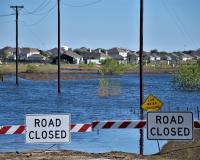
Vibrant Environment
All | Biodiversity | Climate Change and Sustainability | Environmental Justice | Governance and Rule of Law | Land Use and Natural Resources | Oceans and Coasts | Pollution Control

How prepared is the United States to adapt to climate change? To answer this question, on a recent People Places Planet Podcast episode, “Is the U.S. Government Ready for the Climate Crisis? Examining Federal, State, and Local Climate Adaptation,” Staff Attorney Cynthia Harris spoke with three climate experts: Dr.

Ecuador is undoubtedly one of the most megadiverse countries in the world. It currently has 18,439,141.75 hectares of protected areas, which means that 13.7% of its territory is under special protection. Without underestimating the rest of the ecosystems and habitats that make up this small piece of land located in the middle of the world, the Galapagos Islands usually take the limelight. The Galapagos Islands have been declared a natural world heritage and are the reference by which many foreigners identify the country.

On October 2, approximately 25,000 gallons of oil spilled into the Pacific Ocean from a pipeline off the shore of Huntington Beach in Orange County, California. While the full environmental impact of the spill is still under investigation, it is clear that the oil spill threatens the money, time, and effort that have gone into rehabilitating and maintaining nearby wetlands. Dead fish and birds were seen washing up on shore. Oil now coats the rocky beach.

Former railroad turned elevated park, the New York City High Line presents a prime example of creating new green spaces to beautify, ameliorate, and revitalize surrounding communities. Although certainly one of the city’s most popular parks, the High Line also serves as the culprit for a sharp 35% increase in adjacent housing values.

In recent years, Artificial Intelligence (AI) applications have rapidly become more sophisticated and widespread, “even as legal and regulatory frameworks struggle to keep up.” Moreover, AI’s often-overlooked environmental implications are simultaneously “sweeping and quite complicated,” and for all of its promise to help improve the environment, AI could in fact cause environmental harm. With those framing remarks, Andrew Tutt, a Senior Associate with the law firm Arnold & Porter, opened a February 18 webinar on “Environmental Applications & Implications of Artificial Intelligence,” the third in ELI’s GreenTech series running through 2021.

What products did you use this morning as you got ready for your day? Shampoo? Soap? Deodorant? Makeup? Likely at least one of these, along with other personal care products. The Environmental Working Group found that women in the United States use an average of 12 personal care products each day, and men an average of six. And, while many of the chemicals in these products likely pose minimal risk, some chemicals found in personal care products have been linked to cancer, reproductive harm, and other health problems. Further, women of color face disproportionate impacts. On average, women of color use more beauty products than white women, and the beauty products they use disproportionately expose them to hazardous ingredients.

Renewed interest in outer space has brought new sources of investment and technology. Last year witnessed 110 orbital launches, tied for the highest annual number since the early 2000s. Increased activity in outer space will accelerate potential environmental effects; for instance, space mining could lead to natural resources being extracted from the moon, Mars and other planets, and asteroids. The primary environmental issues include debris, pollution of earth’s atmosphere, and biological or nuclear contamination.
In this month’s issue of ELR—The Environmental Law Reporter, Scot W. Anderson, Julia La Manna, and Korey J. Christensen discuss the legal framework surrounding development of natural resources in outer space. The authors provide an overview of space mining regulations generally, and examine regulatory efforts to mitigate environmental issues.

A recent study by Eric Martinez and Christoph Winter surveyed over 500 legal academics regarding how and to what degree the law can protect future generations. Here, I discuss some of the authors’ findings and the implications for using law to take action against climate change.
The survey asked legal academics for their views on legal protection of future generations and other groups, which groups could be granted legal standing, the ability of law to influence the long-term future, and specific areas of law and sources of risk. Climate change and environmental law were featured in several questions, as both are commonly associated with future generations and the long-term future. This can be seen, for example, in the rise of environmental constitutionalism, scholarship on representing future people in climate governance and intergenerational justice, as well as a rapid increase in climate litigation, with global cases nearly doubling from 2017 to 2020.

“The United States has a very effective liability management policy and legal framework, but that same framework has some unintended consequences for the circular economy,” including risk aversion that can create barriers to circular economy businesses, said John Lovenburg, Vice President of Environment at BNSF Railway, in his opening remarks as moderator of ELI’s fourth GreenTech webinar March 24, 2021, on “The Emerging Circular Economy.”

Despite popular belief, natural hazards are not “great equalizers.” Environmental burdens fall disproportionately on marginalized groups. These inequities stem from legacies of racial injustice and systemic income disparities that have caused certain neighborhoods to have both poor infrastructure and limited access to financial resources, creating greater threats from hazard-related damage and difficulty with recovery efforts.